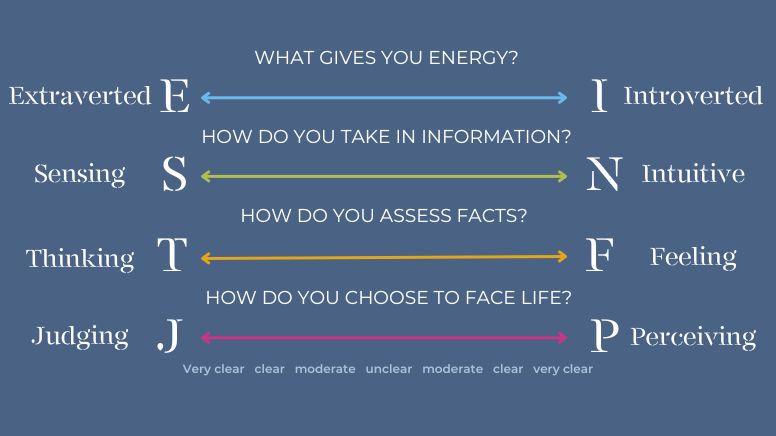Career advice
Personality survey: A tool for a better work life

How is it that you can be really good at something that you don't actually enjoy doing? Kim Knudsen's answer to that question is that you work in a way that is contrary to your usual and preferred way of functioning – i.e. your preferences. And it is precisely your preferences that you can learn about when you take a personality type survey.
The career counsellor has often faced this question when a member had to take a personality survey: "Should I take the test based on how I am at work or at home - because I am not the same?". And he understands the question because, of course, context affects us. But according to the theory behind the personality survey, our basic preferences are the same regardless of the situation. When we don't act in accordance with our preference, it's because of a learned behaviour. It is when you relax from your own and other people's expectations and the demands of the situation and can truly be yourself that preferences can emerge most clearly.
Of course, learned or adapted behaviour may be necessary, but in the long run it is exhausting and affects your well-being. Kim Knudsen remembers a former colleague who, after many years as a teacher, quit his job. His colleagues were surprised because, as they said, "you're a marvellous teacher", to which he replied "yes, thank you, but I don't enjoy it and it drains me of all my energy". So you can be really good at something that you don't enjoy because it's against your preferences.
Kim Knudsen has noticed a generally increased awareness of the fact that employees perform best when they enjoy their work. In other words, more people are becoming aware of whether their job and the working environment match their preferences. He adds: "There are things in every job that you might not exactly enjoy. The crucial thing is the tipping point - that there is not an overload of tasks that drain your energy."
IDA's members: The world's best problem solvers
The most well-known personality surveys, e.g. 16 Personalities or the the Jungian Type Index (JTI survey) which you can take for free online, describe your preferences in terms of 4 dimensions:
- What gives you energy
- How you take in information
- How you assess facts
- How you choose to face life

Depending on where you lie on the scale between the opposing terms, your result will be a letter code. The most common type among IDA's members is the introvert (I), who works with known facts (S), bases decisions on impersonal analysis and logic (T) and prefers a planned and ordered lifestyle (J).
"The strength of IDA's members is that they are the best in the world at seeing the holes in the cheese, as we say about problem-solving skills in Denmark. They have the ability to think critically and analyze processes", says Kim Knudsen and points to Denmark's tallest building outside the window: "For example, I am completely confident that this house will not fall over, because it has been thought, analyzed and calculated by some S- types similar to many IDA members.” The creative N-type is not overrepresented among IDA's members, but fortunately they are also there so they can invent solutions to society's challenges.
"I can't understand why they take it so personally." This is a statement Kim has often heard from members who may have experienced conflicts at work. Many of IDA's members have a clear distinction between subject and object. This is of course a strength in analytical work, but in working relationships it is a weakness, because they do not realise how much the personal can be important to their colleagues, who base decisions on personal values (F-types).
Extrovert or introvert is not the main difference between people
Even if you haven't taken a personality survey, you probably know the difference between being an extrovert and an introvert. Kim Knudsen believes that this contrast has become the most common way of describing the difference between people because it is the dimension that is easiest to understand and observe. He also believes that this focus has been relevant for emphasising the preferences and strengths of introverts. The culture in many workplaces, with open-plan offices, workshops and social activities, favours the needs of extroverts more than introverts.
You don't have to search long on the internet to find various guides and advice for introverts - also here on ida.dk: Speak up as an introvert and Introvert? How to become good at networking.
On the other hand, you won't find good advice and guides for extroverts. In IDA, we don't have a guide for extroverts either, but a good place to start, according to Kim Knudsen, is to remember that you are naturally equipped with one mouth and two ears. So even if as an extrovert you speak first and think as you speak (as an introvert it's the other way round), it can be good to listen first. In addition, extroverts may need to be extra careful not to burn out in a socially demanding labour market, because even though as an extrovert you get energy from being with others, there is of course a limit.
Kim Knudsen wants to shift the focus from extroverts and introverts to the dimension of How we take in information. This is where we see the biggest difference between people - the difference between working with known facts (the S-type) and looking for opportunities and connections (the N-type): Where the S-type is present here and now with all senses focused on concrete details, the N-type looks to the future, to what can be improved, developed and changed. That said, a partnership between S- and N-types is great when there is mutual respect with an eye for differences: The N-type gets the ideas and the S-type takes responsibility for realising them. For example, the Tesla car would never have been realised without such cooperation.
Taking a personality survey was an eye-opener
IDA's career counsellor has encountered scepticism about personality tests and surveys from IDA members, but also that the scepticism has been put to rest: "Normally I don't care much for airy-fairy thinking, but this was useful", as a former participant on a course with personality surveys said. On several occasions, Kim Knudsen has had the experience that it has almost been a revelation for members to become aware of their preferences and strengths.
And it's not just the career counsellor who speaks highly of the effect of becoming aware of your personality type. IDA member Lars Bak, who works as a project manager in the Ministry of Defence, has attended the course The informal leader in IDA, where he took a JTI type test. He says: "It was a huge eye-opener for me. When I came home from the course and showed my wife the test results, I said that I wish I had known this about myself when I was younger. It would have given me a greater sense of confidence and security."
For Lars, the biggest benefit from the course was the personality survey. It has given him an understanding of his own and others' preferences and needs - insights that he now uses as a project manager to better understand his project participants: Who needs careful planning and who thrives on flexible structures? Who wants to deal with the concrete details, and who is motivated by idea and strategy development? And who has other needs, for example, where I need to be careful in my communication and also argue more value-based arguments?
Understanding personality types has also meant that Lars can now better prepare himself and his workshop participants. Not everyone necessarily enjoys brainstorming and post IT exercises, for example, which often favour extroverts. Therefore, Lars focuses on catering for the needs of introverts, for example by preparing the workshop participants in advance on the topics for a brainstorming exercise. The aim is to ensure that everyone has a good experience and that the end product is likely to be even better.
The personality survey and awareness of preferences has also boosted Lars' own career development, and he is now studying for a diploma in management and is part of the Danish Defence Talent Programme. The only downside is that he wishes he had taken a personality survey much earlier in his working life. An important lesson for IDA's young members.
Don't keep the test results to yourself
IDA's experienced career counsellor stresses that the result of the personality survey is not a scientific truth, but a tool for reflection and dialogue. You must therefore actively use the test results to benefit from them, and it is therefore a good idea to ask yourself:
- When is it an advantage to be like this in your job?
- When is it a disadvantage? - For example, in what situations can it cause conflicts?
- When you meet your opposite, what happens?
And you should not keep your reflections to yourself, but share them with your colleagues and manager. This could be, for example, the next time you have some form of team building or follow up on a workplace assessment or well-being survey in your department. Awareness of our own and others' types teaches us that what we might interpret as ill will or lack of ability in others is simply about fundamentally different ways of approaching work tasks and preferring a different framework for work life.
If you're not the type to shout your realisations about yourself and your preferences from the rooftops, you can instead record them in a well-being logbook. Here you can note which situations and tasks give you a sense of enjoyment while you perform, and also, conversely, when you feel drained and misunderstood. You can share these notes with your manager when you have 1:1 talks. That way, you have a good basis for having a conversation about how your job content can match your preferences.
Kim Knudsen tells the story of a member who, after a personality survey, suddenly realised why he was unhappy in a job. He was the type of person who prefers to work with known facts, but he had a job where he had to come up with the tasks himself.
If you are looking for a job, being aware of your preferences is also worth its weight in gold. If you can say at a job interview, for example, "I thrive best when success is shared and I can develop ideas together with others", you are using your self-awareness constructively because you are saying it out loud. This is a win-win for both yourself and a future employer.
A part of
Career AdviceTake a personality survey online
IDA recommends the online surveys 16 Personalities or the the Jungian Type Index (JTI survey)